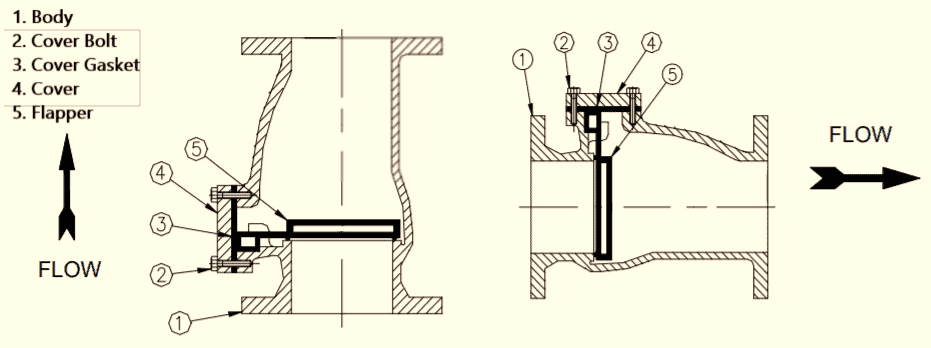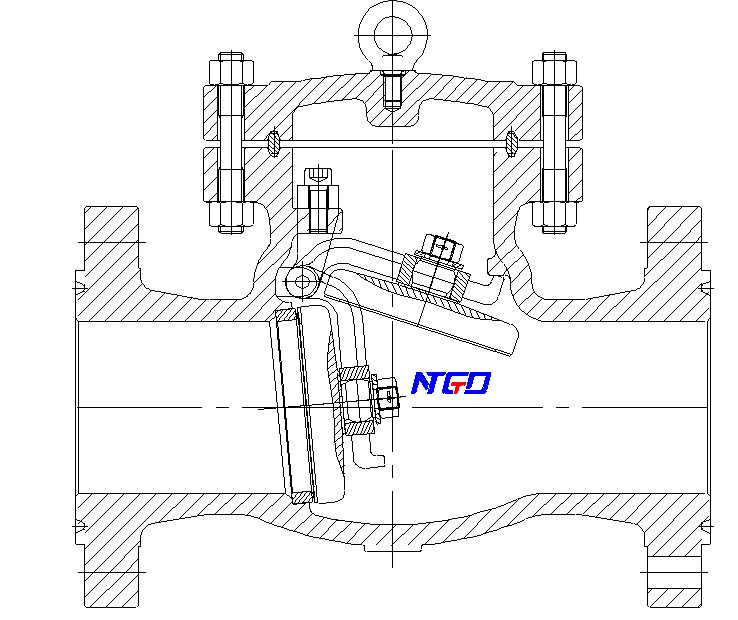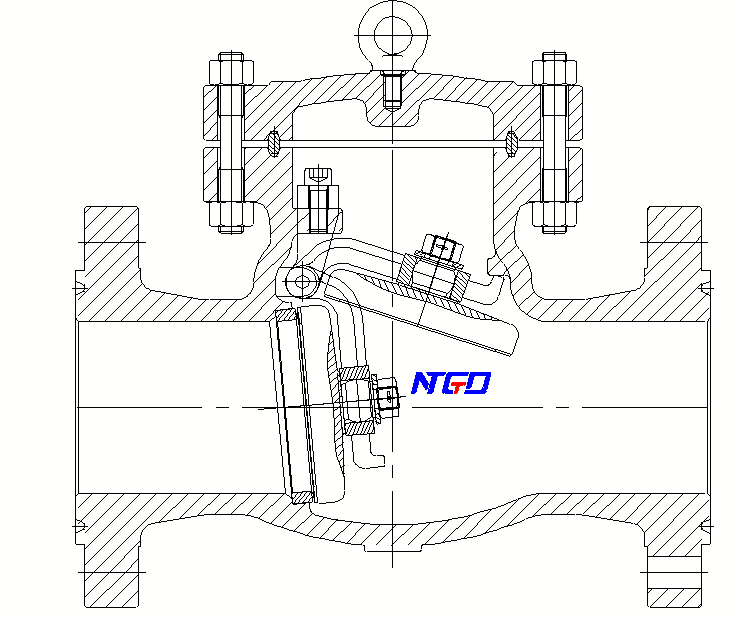The check valve is intended to prevent media from returning to the pipeline. When the pressure reaches zero, the valve closes completely to prevent backflow.
Check valves belong to the group of automatic valves, which are mainly used in pipelines where the medium flows in one direction and which allow the medium to flow only in one direction to avoid accidents. Pressure drops and turbulence with these types of valves are very low. This type of valve must generally be installed horizontally in the pipeline, but can also be installed vertically, as the disc cannot reach the blocking position where it is stuck in the open position.
Working principle of a check valve
The check valve has an integrated rocker structure. All valve opening and closing parts are installed in the valve body and do not penetrate the valve body, except the gasket and the center flange sealing ring. There is no general leak point, eliminating the possibility of valve leakage. The rocker arm connection between the check valve and the valve flap has a spherical connection structure, so that the valve flap has a certain degree of freedom in the range of 360 degrees and the corresponding track position compensation be carried out. When the medium flows downstream, the medium flows through the valve flap and opens the valve. The pressure at which the valve opens is called the opening pressure. When the medium pressure drops below the opening pressure, the valve closes automatically. When the medium flows back, the force of the medium seals the valve flap with the valve seat and closes the valve.

Check valve: structural features
1. The overall structure is simple and compact, giving it a beautiful appearance.
2. When the average pressure of a check valve drops below its opening pressure, the valve flap closes quickly, making the water hammer pressure very low.
3. Valve flap reduces leakage of all housing components through the suspension mechanism.
4. Flow through the check valve is unobstructed and offers low fluid resistance to the medium.
5. It is very sensitive to small pressure changes and also has good sealing performance.
6. The check valve has a short disc stroke, which means that the effect of closing the valve is very small.
7. Long service life as wear is minimal, ensuring high reliability.
8. Horizontal or vertical channel can be used, easy to install.
9. The rocker arm and valve structure are provided with a ball joint, so that the valve flap has a certain degree of freedom in the range of 360° and acceptable track position compensation.
Product Standards
Construction standard: API602, ASMEB16.34, API6D
Frame Length: ASME B16.10
Material and temperature: ASME B16.34
Test standard: API598, API6D
Application of check valve
A check valve can be used for a variety of media, such as water, steam, oil, nitric acid, acetic acid, strong oxidizing media and urea. They are mainly used in petroleum, chemical, pharmaceutical, fertilizer, energy and other pipelines. It is suitable for clean media and not for media with solid particles and high viscosity.
If the medium flow is pulsating and low, the use of a check valve is not recommended. This causes the valve disc to hit the valve seat, causing significant damage to the valve. This causes wear on both discs, the oscillating disc may become loose and as a result the valve will no longer function properly.
Check valve maintenance
The check valve does not require much maintenance. It is considered more durable. However, leaks may occur if foreign objects become trapped between the disc and the seat. This leads to compromised valve function.
1. To prevent damage to the check valve, keep it clean by regularly wiping off dust and dirt.
2. Always check the valve regularly.
• Check for possible leaks.
• If there is a serious leak, replace the valve.
• Look for signs of corrosion, rust and wear.
• Check the pressure and temperature of the fluid flowing through the valve.
• Make sure parameters are within valve limits.
3. When replacing the valve, clean the removed valve by overhauling it, wash all parts thoroughly with hydraulic fluid or the medium for which it is used. Check for dirt and scratches. Check valve for corrosion, wear or rough surface. Smooth, polish and reassemble.
4. The valve should always be stored lubricated in a dry and ventilated place to avoid moisture, rain and rust.
5. The opening and closing parts must be in the locking device during storage or transportation, and the following work must be carried out:
• The valve disc must be fixed in the open position.
• Internal ports at both ends of the diameter are blocked with foam boards and must be tightly closed with plugs to prevent dust and rust and to keep the channels clean and the end faces flat.
6. If used for a long time, it should be checked regularly. Check the condition of dirt and rust protection on the two channels, sealing surface and welded joint every three months. After cleaning off dirt and rust, reapply rust-preventing oil to protect.

Installation and use of check valves
1. Dock type rotary check valve is mounted vertically on the horizontal pipe and is used when the vessels are fully open.
2. The dock-type rotary check valve must be installed at the priority level of an official road, and can be mounted on a vertical pipeline with medium flow from bottom to top.
3. The following works must be carried out before installation:
■ Remove the clogged cap and foam board at both ends of the valve body.
■ Remove the lubricating paper from the surface of the valve disc to remove the grease from the surface of the valve disc, clean the internal cavity and remove the grease.
■ Check disc movement by holding it away from the seat to ensure it moves freely.
■ Check the valve ends for burrs or edges that prevent a proper seal.
■ The valve must be installed in the direction of the flow arrow.
■ If the valve is installed vertically,
■ If the valve is installed horizontally, the cover must be upwards and the flow must be upwards.
4. During installation, media flow must be limited and free media flow must be guaranteed.
5. The medium flowing through the pipeline must not contain hard particles so as not to damage the sealing surface.
Bugs and troubleshooting
Check valves are very critical components in many situations as backflow is sometimes very harmful. Therefore, it is necessary to identify check valve symptoms as early as possible to avoid line shutdown and costly repairs.
The most common problems with check valves are:
• Water Hammer – A water hammer is a pressure spike or high pressure wave that occurs when a moving fluid suddenly stops or changes direction. This typically occurs with “flap valve” type test valves, where reversing the flow downward causes the valve to close suddenly, resulting in a pressure wave propagating through the line. Water hammer can cause damage to pipes, fittings and valves.
• Improper installation, maintenance and assembly – As with any mechanical device, improper installation, maintenance and assembly of control valves can result in costly and time-consuming damage and eventual failure. For piping device, the valve must be positioned in the correct direction during installation. It is also important to remember that not all control valves work the same. Pipe flow performance specifications, valve installation location, and whether the valve will be mounted in a horizontal or vertical position must be considered.
• Backflow – Backflow occurs when the valve allows water to flow back to the upstream side of the check valve; in other words, there is flow through the valve in two directions. This can have a detrimental effect on devices such as drain pumps, where backflow into the pump can cause the impeller to rotate in the opposite direction, causing damage to the pumps.
• Debris in the pipeline – Debris can get stuck in the test valve in the pipeline, causing it to stick in the open or closed position. Therefore, fast-moving dirt can impact the one-way test valve and damage the internal mechanism. This can cause parts of the valve to break or come loose, allowing more debris to flow downstream.
Proper and regular preventative maintenance is the key to preventing check valve failures and ensuring long valve life.
The first and most important measure to prevent valve failure is to keep the piping and valves clean and free of debris. This can be achieved by installing filters and covers where appropriate. Regular flushing of the plumbing system can also be performed to remove accumulated debris and minimize contaminant buildup.
Another effective method to reduce premature valve failure is to lubricate the valves. Check valves consist of several moving parts. Reducing friction between these components through lubrication can therefore extend the life of valve components, improve overall efficiency and ensure efficient operation.
Finally, valves must be positioned correctly and used according to instructions. Improper valve installation or using the wrong type of check valve can reduce valve life. There should also be a regular maintenance schedule to ensure that faulty valves are replaced at the first sign of failure.
Examples:
Fault location: Leak in the connection between the valve cover and the valve body.
The cause of the error:
1. The connecting screw nut is not tightened or the cloth is loosened evenly.
2. The sealing surface of the center flange is damaged or dirty.
3. The seal is damaged.
Solution:
1. Tighten the nut evenly.
2. Repair the sealing surface and remove dirt.
3. Replace the gasket.
Fault location: Leak at the valve disc sealing surface and valve seat.
The cause of failure:
1. Dirt gets trapped between the sealing surfaces.
2. The sealing surface is damaged.
Solution:
1. Open and clean the valve body.
2. Regrind or reprocess.
Like all check valves, check valves are used to prevent backflow into the line. The pressure of fluid flowing through a system opens the valve, while a reversal of flow closes the valve. The check valve works by allowing flow forces to push the closure part. It is a flap that rotates or oscillates around a support axis. Swinging the disc away from the valve seat allows flow in the forward direction, and when flow is stopped upstream, it returns to the valve seat to prevent backflow. The check valve design is one of the most common and best general purpose check valves. These valves produce the lowest pressure drop, while the internal contours and shapes allow them to open fully at low fluid velocities, creating a smooth flow path through the valve compared to other check valves of the same size. The design is simple and easy to maintain and can be used for horizontal or vertical (liquid flows upward) pipe configurations. This makes the check valve suitable for a wide range of applications such as petroleum, chemical, pharmaceutical, fertilizer, energy and other industries.
NTGD valve is professional check valve manufacturer If you have any questions, please feel free to contact us


























































